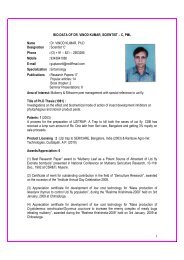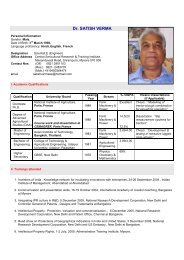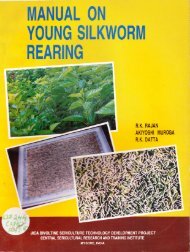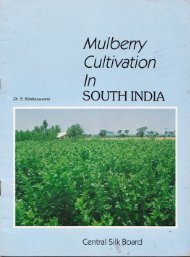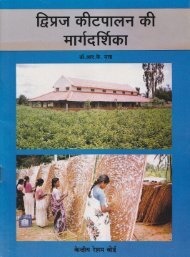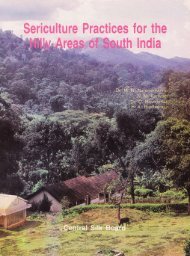IN
mulberry cultivation as high bush and - Central Sericultural ...
mulberry cultivation as high bush and - Central Sericultural ...
Create successful ePaper yourself
Turn your PDF publications into a flip-book with our unique Google optimized e-Paper software.
MULBERRY CULTIVATION AS HIGH BUSH AND<br />
SMALL TREE <strong>IN</strong> HILLY REGIONS<br />
S. B. DAND<strong>IN</strong><br />
AND<br />
K. SENGUPTA<br />
CENTRAL SERICULTURAL RESEARCH & TRA<strong>IN</strong><strong>IN</strong>G <strong>IN</strong>STITUTE<br />
(CENTRAL S|LK BOARD<br />
- MTNTSTRY OF TEXflLES -<br />
SRIRAMPURA, MYSORE-57o OO8.<br />
GOW. OF rNDrA)
Mulberry Gultivation as High Bush and<br />
Small Tree in HillY Regions<br />
S. B. DAND<strong>IN</strong><br />
AND<br />
K. SENGUPTA<br />
1988<br />
Gentral Sericultural Besearch & Training lnstitute<br />
(CENTR,AL SILK BOAR,D<br />
- M<strong>IN</strong>ISTII,Y OF TEXTILES _ GO\II. OIi <strong>IN</strong>DIA)<br />
SRIR,AMPURA, MYSORE - 570 OO8
<strong>IN</strong>TRODUCTION<br />
lv{ulberry a basic raw material for sericulture industry is a deciduous<br />
or moist deciduous tree species found naturally distributed along the foot<br />
hills of Himalaya right from J & K to North Eastern States upto an elevation<br />
of 9000' MSL. Genus Morus to which mulberry belongs forms a dominant<br />
forest flora in parts of J & K; Kumaon and Garhwal hills of Central Himalaya<br />
and in most of the North Eastern forests extending upto Unani region.<br />
In fact, in most of these forest areas, silkworms are reared by local people<br />
only from leaf available in these forest trees. In addition, mutrberry is found<br />
in most of the public places, court yard of the houses as a popular fruit tree.<br />
Owing to the fast spread of sericulture to most of the states with<br />
heterogeneous agroclimatic conditions, different cultivation methods have<br />
been evolved and being practiced. This has become possible only because<br />
of the wider adaptabitity of mulberry'plant to different agroclinoatic conditions<br />
and cultural practices. At present mulberry is being cultivated as a<br />
low bush with co'rrparatively closer spacing of 2' x 6" to 3' x 3' in plains<br />
of South India and West Bengal to obtain maximum leaf yield and easy<br />
harvest. On the other hand, mulberry is cultivated as a large/medium tree<br />
with wider spacing of 10' x 10' to 2O' x 2O' in Jammu and Kashmir area.<br />
Of late, dwarf tree plantation with 5' x 5' and 5' x 10' spacing is becoming<br />
popular in this state (Fig. 1). trn temperate countries like China (Northern<br />
part) Japan and Korea, mulberry is cultivated as high bush with closer<br />
spacing between plants and wider spacing between rows. The common<br />
spacing adopted is 0.6 x 1.5 - 2.0 m. In USSR, it isreported that mulberry<br />
is grown as small/medium tree with wider spacing and in between, cotton<br />
is cultivated. In addition, mulberry trees are also planted all along the<br />
boundaries of farm and irrigation channels. He.nce, mulberry is grown in<br />
different forms in different parts of the world depending on the climatic<br />
conditions and cultural practices.<br />
Growing rnulberry as tree in India though not new, has several<br />
advantages and seems to be quite promising. As so% of the area under<br />
mulberry is rain dependent for its moisture requirement, growing mulberry<br />
as -hiqh<br />
bush,/low tree helps the root system to develop more extensively<br />
and deeper into the soil. Problem of cultivation of large area of non-
1. High bush and small tree type of plantation.<br />
areable land available in hilly terrains of the country especially in western<br />
Ghats and central India can be easily solved by cultivating mulberry as<br />
a smalllmedium tree. Mulberry can grow on marginal lands and produce<br />
4
trarge amount of leaf which will help the rural mass to take up sericulture.<br />
In addition, it can provide sufficient fuel material and effectively<br />
check the soil erosion. Hence mulberry can as well be included as one<br />
of the component in social forestry and water shed management schemes.<br />
Finally planting mulberry on farm road sides, on the bunds of farm ponds<br />
and fish ponds; in the eourtyard of farmldwelling house; all dong the<br />
boundries of field etc., will help in getting additional amount of suitable<br />
leaf for late age worms and also fuel material. Realising the above merits,<br />
growing mulberry as a small tree is gaining momentum. Of late, Central<br />
Silk Board and various State Sericultural Departments are coming forward<br />
to take up this programme in water shed management, social forestry and<br />
development of non-aerable lands.<br />
At present mulberry is extensively grown as small bush with closer<br />
spacing and suitable cultural practices have been evolved for this. On the<br />
other hand, there is not much information about growing mulberry as highbush/small<br />
or medium tree and cultural operations to be followed. Hence,<br />
this document is prepared to provide some guidelines covering all the aspects<br />
right from land selection to economics. The suggestions may not be applicable<br />
in toto to all the agroclimatic or cultural zones. Howevero with suitable<br />
modifications this will serve by and large the main object of growing<br />
mulberry as high bush or small tree.<br />
Selection of site and land preparation<br />
Mulberry can be grown in various topography and soil types. Flat,<br />
elevated lands are mote suitable for growing mulberry as bush with closer<br />
spacing, whereas tree plantation can be raised in all types of topography<br />
except steep slopy terrains and submersible marshy lands. If the land is<br />
having gentle slope, it can be levelled with minor land shaping and providing<br />
suitable type of bunds across the slope. It the degree of slope is morg<br />
contour bunding, terrace planting or contour line planting can be adopted.<br />
In any case, so.l cutting and shifting should be kept at minimum as these<br />
soils are more vulnerable to erosion. ln more slopy areas, platform for<br />
individual plants on contour lines is more suitable as the same involves less<br />
soil cutting.<br />
Though mulberry can be glown in any type of soil, well drained<br />
deep clay loam soils are more suitable for luxurient growth. soil pH of<br />
6.2 ta 6.8 is considered optimum. However, alkaiine soils with high pH<br />
can be rectified by application of gypsum followed by flooding and draining
away the water. Application of large amount of green manure will also<br />
help in reducing the alkalinity. similarly, acidic soils can be corrected by<br />
application of required amount of lime or dolomite before cultivation.<br />
Spacing and preparation of pits<br />
Spacing for tree planting depends on soil topography, extent of land<br />
available for cultivation and training method. In case of lands with gentle<br />
slope, 5' x 5' spacing can be adopted. In case of slopy lands, 5' from<br />
plant to plant and 1o from row to row is suggested. Plants must be planted<br />
in rows across the slope. In large extent of forest lands with undulating<br />
surface, 10' x 10' spacing is more suitable" Generally, in smaller holdings<br />
of less slope, 5' x 5' spacing and in larger areas of undulating or slopy terrain<br />
5' x 10' or 10' x 10' spacing can be adopted. Number of plants/ha<br />
and type of pits required etc., are given in Table-l.<br />
Land preparation for tree planting is much easier than bush cultivation.<br />
For tree plantation, depending on the spacing, spots fo,r pits are<br />
to be marked with pegs. In case of deep textured loose soils, 45 x 45 x 45<br />
cm and in hard shallow soils, 60 x 60 x 60 cm size pits can be dug. pit<br />
preparation should be started soon after receipt of pre-monsoon showers.<br />
while preparing pits, a1l root stocks and other plant material must be completely<br />
removed. Before a week of planting, pits must be filled with a<br />
mixture of well decomposed farm yard manure or compost and soil. For<br />
each pit 5 kg (one iron pan) of FyM or compost must be applied. If<br />
the soil is clay, about two iron pans of sand or red earth should be incorporated<br />
to each pit. As most of the hilly/forest soils are acidic with low pH,<br />
application of lime is necessary. 500 gms of agricultural lime can be incorporated<br />
into each pit along with farm yard manure.<br />
Variety and Planting Material<br />
Kanva-2 (M5) variety in south India, BER sl (Mandalya) in west<br />
Bengal (Fig. 2) and sujanpur-S in North are found suitable for growing<br />
as trees and can form good crown by proper training. These varieties are<br />
good in growth and give high leaf yield of good qualify. In addition, these<br />
are found amenable to vegetative propagation. Apart from these varieties,<br />
some new varieties are also being tried for their suitability as trees. fire<br />
same will be made available to farmers soon after the completion of trial.<br />
6
For raising trees or high bushes of<br />
found most suitable " Saplings of 5 months<br />
used for planting. As saplings have a well<br />
mulberry, sapling planting is<br />
age with 5'-6' height can be<br />
developed root system, they<br />
)i:+r'i,:i:r;:l; :<br />
/.;,<br />
#H*<br />
..i 'v 9<br />
*e*x #<br />
"#mt%<br />
ffffi<br />
ffi<br />
2. Variety Kanva-2 and Ber Sl<br />
establish quickly and form sufficient canopy in a short period. Root system<br />
also grows fast and to the deeper layers of soil which will help in withstanding<br />
moisture stress. Saplings must be raised 5-6 months earlier to planting.<br />
February month is most suitable for this pu{pose. Flat elevated trand with<br />
good drainage must be selected for preparation of nursery beds. The site<br />
must have an assured irrigatibn source as the nursery beds require regular<br />
watering till June. In closer spacing of 5' x 5', 4350 plants are required for<br />
one hectare. Hence, arrangements must be made to raise 5000 saplings.<br />
8' x 4' stzn bed can accornmodate 192 cuttings " Totally about, ,26<br />
beds of this size are required to raise enough saplings. Nursery site must
e given a deep digging and all the root,/grass stocks must be removed" Beds<br />
of 8' x 4' size must be rnarked with bunds and every nursery bed must be<br />
provided with channel. 2o kg (4 bandli) of well decomposed Farm yard<br />
Manure and 50 kg (10 bandli) sand or red earth must be applied followed<br />
by second round of digging to mix the FyM and sand into the soil. seed<br />
cuttings must be 6"-8" in trength with 3-4 healthy buds. cuttings must<br />
have clean cut on both ends. cuttings must be ptanteo in g,, x 3,, ipacing.<br />
After one month of planting, first round of weeding must be giuen and aftJr<br />
two months a booster dose of urea or suphala at the rate of 500 g per bed<br />
must be applied. Regular irrigation at an interval of 5-6 dayf must begiven.<br />
saplings will attain a height of 5, - 6, attw 5 months *a ,r"ay t"rleplanting<br />
(Fig' 3) . while uprooting, enough care must be given and no<br />
damage should be caused to the basi. saplings must be planted imrnedi_<br />
ately after uprooting without long storage.<br />
Flanting Season and Methorl<br />
Planting should be started only after the regular onset of monsoon<br />
so that there will be assured rnoisture suppry after"pranting. one sapling<br />
must be used in each pit for planting ana lt snouta be piaced deep and<br />
FFi.,il'i:.r,1ffi Effi :,l:. i<br />
3. Saplings suitable for plantation.
straight in the centre of the pit by removing some so l. Soil around the<br />
sapling must be pressed firmly. As saplings are 5' - 6' tdl they should<br />
be protected frorn wind by providing a support of a stick and tied to it<br />
pro,perly (Fig. a). Soon after the planting, pot watering has to be attended<br />
if there are no rains on the following days.<br />
After cilre of ptrantation<br />
As planting is done during monsoon season, they get established<br />
quiclcly. Sprouting starts after 10-15 days of planting and upto one month<br />
all the buds must be allowed tc sprout. After one month, all the lower<br />
,ds<br />
" .,"'"8&'n*<br />
4. Support for Mulberry plants for straight growth.
uds except the top 5-6 should be removed carefully \ryithout damaging the<br />
bark. weeds grown around the plants should be removed regularly at<br />
least once in a month by the help of weeding sickle. pot watering must be<br />
attended in case of failure of rains during this period. After three months<br />
of planting and. Znd round of weeding, about 25 gms of suphala should be<br />
applied in a trench made around each plant and the same should be closed.<br />
2nd dose of fertilizer should be given in the forrn of urea after 5-6 months<br />
of planting. About 25 gms of urea is sufficient for each plant. 2nd dose<br />
of. fettilizer must be given before the cessation of monsoon when there will<br />
be enough moisture in the soil.<br />
Duriog the first year of planting, a1l the lower bunds should be re<br />
moved regularly. Plants must be pro ected from grazing animals. AI<br />
around the plantation, green fencing of. Gliricidia or Durantha must be<br />
raised. Barbed wire fencing can also be fixed if possible to prevent<br />
the entry of stray cattles, sheeps and goats which cause considerable iu-ugu<br />
to plants. Details of cultural operations, expendituro etc., for planting and<br />
establishment of one ha of plantation are given in Table_l.<br />
culfural operations during Znd, 3rd and 4th yea,r of plantation<br />
Plants will attain a height of g'-10' after one year of planting. Before<br />
the onset of monsoon, plants must be given lst p.""i"g ui u n ight of a,<br />
frorn the ground in closer spacing of 5' x 5' *a at a height of<br />
5.5-6' in wider spacing of 5' x 10' and 10' x 10, leaving 3-4 buds on each<br />
primary'branch (6-8 inches) as shown in Fig. 5. Soon after pruning, 5 kg<br />
(one iron pan) of well decomposed FyM or compost must be applied at the<br />
base followed by thorough digging around each plant. Altei-cigging, a<br />
basin of 2' radius around each plant must be formed for water retention.<br />
After one month of pruning when buds start sprouting, chemical fertilizers<br />
must be applied. lst dose oJ NpK complex f.ertilizer at the rate of 30 g/plant<br />
should be given in a trench of g"-lo" deep around each plant. 2nd round<br />
of weeding must be given after two months of pruning. 'znd, dose of fertilizer<br />
must be given in the form of urea at the rate of 3lo g/plant after taking<br />
second leaf harvest.<br />
soon after ptfrg, the inter prant/rcw area can be grven a light<br />
plolghing/digging and green manure "ropr<br />
like sunhemp or Dhaincha or<br />
pulse crops like Horsegram, cow pea or Green gr:un can te $own as detailed<br />
in preceeding paragraph (Fig. 6).<br />
l0
[,eaf Han'est<br />
First leaf harvest can be obtained after 7o days of pruning. Leaves<br />
must be harvested oniy by leaf plucking and terminal buds should not be<br />
5. Pruning of Mulberry Plants<br />
removed during lst and 2nd harvests. In a similar way 2-3 more leaf harvests<br />
can be obtained at an interval of 80.90 days during these years' All<br />
the harvests must be only through leaf plucking. Cultural operations,<br />
amount of leaf availab1e, harvest cost etc., during 2nd, 3td and 4th year<br />
of planting are given in Table-2 along with approxirnate returns.<br />
Maintenance and Leaf harvest from 5th year onwards<br />
Tree plantation starts giving full potential yield from 4th year<br />
onwards. Each tree can be pruned twice a year at an interval of 6 months.<br />
ll
6" Mixed cropp.ing in new plantation.<br />
First pruning can be given during June after the onset of South west monsoon<br />
and 2nd pruning during last week of October or 1st week of November<br />
before the cessation of monsoon. rn closer planting of 5' x 5, spacing,<br />
stump height of 2"3' can be maintained as shown in Fig. 7A. secondaiy<br />
branches must be p,runed at a hoight of 6,'-g,, leaving 3-4 buds from branching<br />
point. In small tree type with 5'x l0' or 10' x 10' spacing, plants must<br />
be regularly pruned at a stump height of about i,-5.5,. Here also<br />
3-4 buds must be left on secondary branches (Fig. 7B). white pruning,<br />
the cut ends and the bark should not be damaged.<br />
Manure and Fertilizer Application<br />
soon after lst pruning in June, 5, l0 and 15 kg of well decornposed<br />
FYld or compost must be applied around every tree in-5, x 5,, 5, x 10-, and<br />
t.o'<br />
1!v spacing respectively foilowed by digging. while digging roots<br />
should not be damaged. After diggrng u 6irio' : ort 2, radius must<br />
be formed around each tree for coniJrviirg *orgh -olrtur". chemical<br />
fertilizer can be uppld twice in a year after a-onih of each pruning. First<br />
dose should be NPK complex feftilizer and 2nd dose should i" "orv<br />
nitrogenous<br />
fettiltzer i.e., urea or calcium ammo4iurn nitrate (cAN) at ihe rate<br />
t2
:+<br />
ffi<br />
71.,<br />
78.<br />
Crown height in high bush type of plantation.<br />
Crown height in small tree type of plantation.<br />
of 50, 60 and 75 g/plant depending on spacing. Fertilizer has to be<br />
applied in a 8"-10" deep trench around the plant at a radius of 21. If the<br />
soil pH is low, lime/dolomite application should be practiced every year<br />
along with farm yard manure.<br />
Weerling and Intercultivation<br />
Base of each plant to a distanc e of Z'must be kept weed free. During<br />
summer, this area must be kept covered with the dry grass and dried parts<br />
of other weeds to prevent the surface evaporation. This will increase<br />
moisture holding capacity and soil fertility.<br />
r3
Intercropping<br />
As large amount of free area is available in between plants and rows,<br />
this area can be well utilized for growing green manure crops viz., Dhaincha,<br />
Sunhemp or grain yielding leguminous crops like Horsegram, Cow Pea',<br />
Green gtam etc. These crops can be grown in between the plants either<br />
by line sowing or by broadcasting. The best time for sowing is South-West<br />
Monsoon season (June) . Soon after 1st annual pruning, seeds can be<br />
broadcasted followed by light digging or hoeing or sown in plough furrows.<br />
Green manure crops should be uprooted and mulched back to the<br />
soil before the onset of flowering and leguminous grain crops can be ha.rvested<br />
after ripening of pods. Intercultivation of such crops help in enriching<br />
soil fertility by providing organic matter and also by root nodulation<br />
bacteria. This practice will effectively check the weed growth and reduces<br />
soil erosion. Sizeable amount of grains and dry podder can be obtained<br />
from grain legumes. In certain areas depending on local practice, short<br />
duration vegetables, co'riender, menthi, radish or mustard can also be<br />
glown. However, gfowing legunrinous crops seelns to be more suitable<br />
because of several advantages.<br />
I-eaf harvest<br />
4-5 leaf harvests can be obtained every year from these trees. 2-3<br />
harvests at an interval of 80-90 days during July to December and two during<br />
remaining 6 months is possible. After 4th year, average yield/tree is around<br />
10-72 kg of which about 6OVo is during monsoon season and remaining<br />
40% during summer. Leaf harvest must be done only by plucking<br />
individual leaves and not by shoot pruning (Fig. 8). Details of cuitural<br />
operations, expenditure and leaf yield are given in Table-3 along with quantity<br />
of layings that can be brushed and cocoon yield.<br />
Economics<br />
During 1st year of planting, mulberry plants are allowed to grow<br />
and form sturdy stumps. During this period more income cannot be generated<br />
by way of leaf for silkworm rearing. One leaf harvest can be taken<br />
during May before pruning the plants. It is estimated that about 200O kg<br />
in 5'x 5', 1000 kg in 5'x 10' and about 5OO kg of leaf in 10'x 10' spacing<br />
can be obtained which will suffice to rear 20O, 100 and 50 dfls respectively.<br />
The shoots obtained from each plant will serve as a best planting material<br />
and $d11 fetch additional income. Expenditure during planting year is<br />
given in Table-l.<br />
l4
'a:i<br />
in<br />
J:.:::!et:.<br />
i$<br />
Eia:{.,j:,<br />
8. Fully grown ftee of 6-7 years and leaf hawesting<br />
Second, third and fourth yeaf are mainly the growth period of plants<br />
when plants will be growing vigourously. Hence, it is advocated to take 4<br />
leaf harvests only by individual leaf plucking as indicated inTable-2. Perusal<br />
of the tabie indicates that the average yield of 2nd, 3td and 4th year would<br />
be around 10,825 kg, 5438 kg and 2716kg in 5'x 5',5' x 10' and L0'x 10'<br />
spacing respectively and production cost pef kg leaf is around 98 paise.<br />
At the rate of 1000 kgl100 dfls, 1080 dfls, 540 dfls and 270 dfls can be<br />
brushed in all the three spacings respectively which will yield sizeable income.<br />
Part of the expenditure incurred towards lea.f harvest can be met<br />
by selling shoots for seed purpose. 5' x 5' spacing, about 2 tonnes of<br />
material per hectare can be obtained which would fetch around Rs. 1000/-.<br />
t5
Full potential of yield can be experienced only frorn 5th year and<br />
there will be 5-lA% increase in leaf yield every year in wider plantation till<br />
8th year. From 5th year onwards the y,ietrd difierence in difterent spacings<br />
narrows down and when plantation reach 7-8 years, all the spacings give<br />
approximately equal leaf yield of tr8-20 mt. It continues ttll 2O-25<br />
years without decline with constant ineome. In addition, large amount<br />
of shoots (8-10 tonnes) will be available every year which can be<br />
used for seed or as fuel. Expenditure, leaf yield, production cost, amount<br />
of layings which can be brushed and approximate cocoon yield are given<br />
in Table-4. Accordingly, 1700-2000 dfls can be reared every year wilh a<br />
minimum of four crops as indicated in Table-4 which will fetch an approxim"ate<br />
gross income of Rs 4,000/ha/year and the net income can<br />
be calculated deducting the expenditure on silkworm rearing. In addition,<br />
8-10 mt of shoots which are available will also fetch an additional income<br />
of Rs. 2,500-3,W/-.<br />
It is sincerely hoped that this document will help those who are<br />
interested in growing mulberry as a tree. However, the expenditure shown<br />
on various items especially on labour will vary from place to place and with<br />
suitable modifieation this can be used as a guideline for implementation.<br />
r6
-a<br />
HU<br />
EU<br />
€C)<br />
+)<br />
ooooaa<br />
6 \D + NOA<br />
d*No<br />
dcl<br />
\o oo<br />
d C.l<br />
$<br />
H *d)<br />
>- d)<br />
9L<br />
C)<br />
c)<br />
li<br />
X<br />
#>r<br />
O<br />
rn<br />
lfr<br />
\ooo !+O<br />
d<br />
oo{<br />
N<br />
ld<br />
d<br />
o<br />
)<br />
,o<br />
bo<br />
a<br />
cd<br />
P<br />
Cd<br />
tr<br />
-a<br />
>. c)<br />
v<br />
l-.<br />
I v)<br />
o<br />
O<br />
x<br />
lal >r<br />
o<br />
cpoco<br />
N<br />
o\<br />
UU<br />
OOO<br />
NOO<br />
NOOO !+<br />
d+o<br />
c{<br />
C)oo<br />
co \o<br />
F-.<br />
rn+<br />
doo 'ca<br />
Cd<br />
O.<br />
>' lr<br />
*r<br />
o<br />
E<br />
)<br />
E<br />
Fi<br />
ttr<br />
o€Hc)<br />
a<br />
-o cd<br />
P aa)<br />
o<br />
li<br />
)<br />
d g<br />
C)<br />
g x<br />
EI<br />
-i<br />
I<br />
,o<br />
F<br />
bo<br />
o)<br />
o<br />
O<br />
\(/)<br />
nl<br />
x9<br />
\n<br />
B-<br />
C)<br />
€<br />
sS Htr<br />
lrd<br />
;E '(g cs<br />
'-l E<br />
6E<br />
\ootsf$oa OOOOOA<br />
eq6l-Sooa<br />
sf, \o<br />
ooc{<br />
ol<br />
o\o<br />
\oIn<br />
c\I<br />
NOO<br />
N+O<br />
o€<br />
coN ca \o<br />
-oE€ e \ €5t<br />
e"$A €s ES Fi $ Eg<br />
EigsigsgEEEEsga!<br />
rn \o F-
.} \n<br />
6t \o<br />
6C\<br />
oto<br />
ooo<br />
6l c.l<br />
frcoCrF<br />
ln\Ohcqt<br />
\oo\l<br />
d\n<br />
\,.l lr) fn<br />
,r;nr*l<br />
oil<br />
d<br />
OOII<br />
cr:coll<br />
rn .+<br />
\n<br />
9V<br />
\a) \n .\o!n<br />
cno<br />
\OO<br />
lt') 6l<br />
to<br />
C-,oo\Ot<br />
\o ca \r<br />
d!?ol<br />
COts<br />
H<br />
ts*LJ<br />
H:hl<br />
Gll<br />
c\T<br />
l,n<br />
ro<br />
rr)<br />
rnll<br />
tra<br />
*,<br />
OOrno<br />
ooc{o<br />
CaF{HN<br />
caHd<br />
Fo\d*<br />
Gtc!=€l<br />
o(.l\oGtt<br />
\o€ *<br />
NN(><br />
Grc'i<br />
8l<br />
!+<br />
€<br />
colr<br />
tsll<br />
rn<br />
F-<br />
N<br />
€<br />
€.* A<br />
\cbo<br />
-ri<br />
\<br />
E e ts6<br />
S F Hp<br />
d - '.-i'<br />
=<br />
il<br />
tt o\o Fi<br />
Fr€<br />
\:E+<br />
ln=(g<br />
"l = d,*F* +<br />
A .! \':x ::i4 €<br />
; g *d$I ipO<br />
H c ;ot O : *-<br />
r.V<br />
g"e s $ Es Se 3 : gg<br />
Y iJ cu a u<br />
=;.::<br />
-<br />
,ff Edo I r.BSB<br />
H*H<br />
=d..,+,.,o
6d<br />
H<br />
6d<br />
q<br />
h<br />
L<br />
d)<br />
3<br />
Li<br />
a)<br />
h<br />
\t<br />
ail<br />
.IJ<br />
fi<br />
cO<br />
q<br />
X<br />
!o<br />
()<br />
ct<br />
AOJ vL{<br />
X<br />
o<br />
()<br />
0)<br />
Lr<br />
*l<br />
QI<br />
oloo<br />
ul<br />
I<br />
ll<br />
//<br />
el -l<br />
t/<br />
a<br />
o<br />
U<br />
>\<br />
i<br />
i/<br />
OO (\l \o<br />
e\l<br />
dca<br />
OO<br />
!qO<br />
\f,-<br />
ol !n<br />
6t<br />
H<br />
i(:io<br />
ol<br />
=!J<br />
+ooN<br />
C\l<br />
t\l<br />
(\t<br />
8€<br />
Ht\<br />
tom<br />
tf: oo<br />
oO \C)<br />
NS<br />
8R<br />
c!<br />
a<br />
t<<br />
d)<br />
lr<br />
't<br />
63<br />
d)<br />
'F<br />
(.)<br />
bo<br />
i.'E x'o<br />
t.)<br />
o<br />
U<br />
I<br />
>,1<br />
o/<br />
lo<br />
-l<br />
c>c) Fo<br />
oo C.t<br />
!n c)<br />
c.;H<br />
v<br />
s E $s H -fB<br />
$ oo Nfi<br />
s<br />
€ ooO<br />
o<br />
C)<br />
al<br />
d)<br />
!<br />
(g<br />
=A<br />
ot<br />
q)<br />
F<br />
6J<br />
IJ C)<br />
'i \s<br />
4a<br />
aE<br />
AVd<br />
*3<br />
Qr: -: s a.<br />
(J F E<br />
H<br />
O^<br />
cd .i HL)<br />
cl X_ cUO<br />
! S{ F oo5.<br />
d '5 g<br />
.!: 5 ti A 13 .g--<br />
oo=<br />
H<br />
a siA Es<br />
II{ AE<br />
1 rHNt-)<br />
oB<br />
E E'F I g:<br />
h tr I *^<br />
.d<br />
-i<br />
€-ep8SIEo =<<br />
E ,$i tr58 F * *- .,*<br />
I EF Eeflg$sf g<br />
!+
\a)<br />
6l<br />
oo<br />
ca o\ \o \o<br />
\O \OI.}H<br />
O\ t'-<br />
N<br />
oo<br />
lo\<br />
IA<br />
lloo<br />
llr<br />
\o<br />
tr)<br />
,r;<br />
ct1<br />
cf)<br />
\nl{<br />
c.ill<br />
ca<br />
OI<br />
NI<br />
t-.<br />
N<br />
O@<br />
FO<br />
C.l<br />
Fr<br />
a)<br />
P C)<br />
\a<br />
\o<br />
\n oo C.l C"{<br />
N<br />
d<br />
coHf-<br />
*Otcrf<br />
e\n<br />
@<br />
lq ,o<br />
ll\o<br />
llo\<br />
cl<br />
*<br />
C)<br />
,rd<br />
s)<br />
p<br />
)<br />
v)<br />
€il<br />
ool<br />
cal<br />
.i.<br />
\n<br />
O\o<br />
+i<br />
\NN<br />
f<br />
o<br />
sf<br />
O o\ \ornrn<br />
O \f, c-Nol<br />
co c\l NooCco<br />
caQ<br />
ooo<br />
lO\ N<br />
li I I o\<br />
rr)<br />
GI<br />
F<br />
a<br />
o<br />
ED<br />
o<br />
cto<br />
N<br />
cr)<br />
*<br />
oit<br />
catt<br />
l,r}l<br />
r-l<br />
oo<br />
()N<br />
oO acr<br />
o.+<br />
bo.<br />
Li<br />
a)<br />
Li<br />
x 3 ^a i<br />
: I co -r- d. 9E U<br />
F 3*{>o ep 5<br />
S EsEIe $ ;<br />
#-rv:<br />
i*gi=g#g<br />
s:iro.€ =aibllE,SeE<br />
d)<br />
L<br />
€<br />
()<br />
X<br />
o<br />
a<br />
H<br />
t<<br />
€<br />
C)<br />
L<br />
€<br />
C)<br />
ci ;o'<br />
O* Q c.r ca!f, rrl \o<br />
** H #H * F<br />
k o<br />
Ir'{
a<br />
d<br />
B tr<br />
FU<br />
o<br />
H()<br />
>-(J<br />
lJ Li<br />
x<br />
O #>"<br />
# a<br />
*l<br />
i<br />
*\o<br />
+Fi<br />
ol co<br />
t-<br />
,-<br />
*coc$<br />
.()<br />
v<br />
l-r<br />
.H<br />
d<br />
E<br />
ed<br />
g<br />
>' L<br />
!<br />
c)<br />
X<br />
N.n<br />
coo { \O :<br />
O- v<br />
qv?<br />
\o rrl<br />
Nc)<br />
cnh<br />
c\<br />
C.I<br />
ts<br />
k o<br />
o<br />
ts{<br />
oot<br />
.il<br />
!l<br />
Kl+<br />
ct<br />
OO O O O OO<br />
ooo * o $ coo\<br />
r<br />
cd<br />
a)<br />
J<br />
C)<br />
O<br />
g<br />
GI<br />
6_)<br />
I<br />
d<br />
i3<br />
a<br />
.co<br />
!)<br />
,o<br />
CI<br />
tr<br />
\Al<br />
(n3<br />
|<br />
..-o I<br />
)<<br />
ta)<br />
9<br />
cg<br />
li cg<br />
/^*<br />
;s '(d€<br />
JE<br />
62<br />
>rl<br />
5l-<br />
*O F- O rnr)<br />
f--i oo H N<br />
-i*<br />
d<br />
oL_a=<br />
d:-.E"re .,.[:H<br />
gg<br />
g3gg E€AFU HS;E<br />
F. i:,€ $$EE H E PR Ffi oi r €F<br />
s ; qa;$€iE€EEE€EE E n:<br />
d: NeO .f \n \O r- ll oo<br />
'ri<br />
C.l<br />
c.I
f* ca !n |f)<br />
ia<br />
q f-O\n<br />
HOOI\<br />
c.l od<br />
.\n<br />
15 II Ẹ tr<br />
cr)<br />
\r)\att<br />
\ f*ll<br />
e<br />
w€<br />
d<br />
$ | 8H I<br />
I<br />
&n<br />
N<br />
f-FF*<br />
c\ooo\ hNcr)<br />
ctl c.l<br />
d<br />
v)<br />
lmrr<br />
;ott= r.rroI<br />
cf)<br />
C)<br />
F o<br />
()<br />
C)<br />
\rlv)tr ..tt<br />
OC)'r<br />
tf|<br />
H*<br />
aa<br />
N I 8fi<br />
s3 \o \o<br />
\J*<br />
r<br />
o<br />
q<br />
d<br />
().<br />
oO<br />
H<br />
\tf<br />
i<br />
TE<br />
c.lN<br />
dO\O\<br />
\OC-\o<br />
.
k<br />
a)<br />
h<br />
tri<br />
o<br />
!<br />
E O<br />
c<br />
&<br />
o()<br />
H<br />
a<br />
"o<br />
bo<br />
o<br />
6<br />
O<br />
o<br />
c<br />
o()<br />
FI<br />
$ op<br />
cd<br />
F<br />
c)<br />
6)<br />
L..<br />
EX<br />
d>r<br />
o=<br />
0.).<br />
G)A<br />
=X irn !<br />
v)<br />
9r.t<br />
?<br />
€p4<br />
bOlrr<br />
(h<br />
(€<br />
0)<br />
a<br />
.j<br />
62<br />
8!88n<br />
eHRKg<br />
OvlOc-rf-\^d(\lcrl<br />
dA*6O\<br />
ot i6 O cq ctt<br />
**<br />
B"TRFS<br />
co
Published by :<br />
Dr. K. Sengupta, Director, Central Sericultural Research anC Training Institute<br />
Manandavadi Road, Srirampura, Mysore-b?0 008 India.<br />
Printed at Jwalamukhi Job Press Banqalore 4 Ph:623921



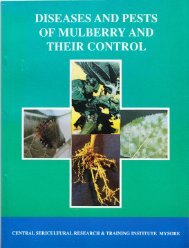

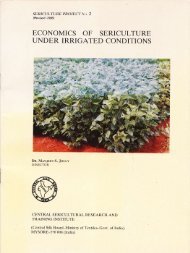
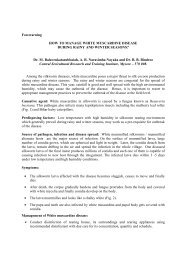
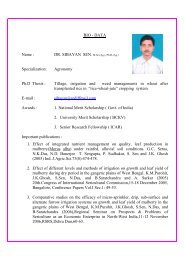
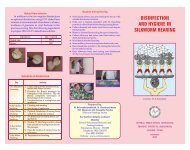
![E}A]\GALORE](https://img.yumpu.com/54052619/1/190x260/eagalore.jpg?quality=85)

